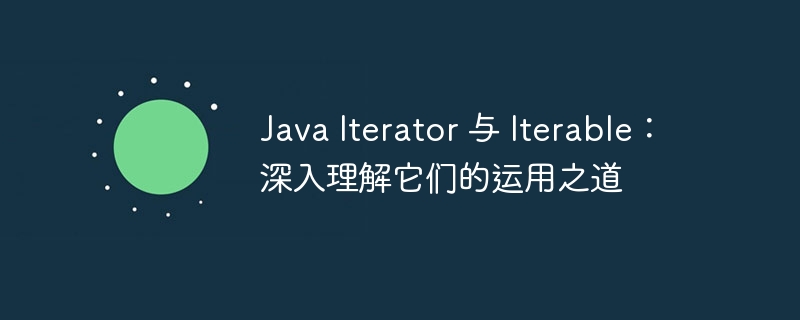Home >Java >javaTutorial >Java Iterator and Iterable: In-depth understanding of how to use them
Java Iterator and Iterable: In-depth understanding of how to use them
- WBOYforward
- 2024-02-20 11:50:07727browse

php editor Xigua analyzes for you the in-depth application of Iterator and Iterable in Java. The Iterator interface is used to traverse the elements in the collection, while the Iterable interface provides a traverser for the collection. A thorough understanding of their clever use will add a lot of skills and convenience to your Java programming journey. In this article, we will focus on how they are used and give you an in-depth understanding of the practical application and flexibility of these two interfaces in Java.
Iterator interface is a core interface in Java CollectionFramework, which defines a common method for traversing a collection. Iterator objects can access the elements in a collection sequentially and can remove elements during the traversal process. The Iterator interface defines the following methods:
- hasNext(): Determine whether there is a next element in the collection.
- next(): Returns the next element in the collection.
- remove(): Remove the current element in the collection.
2. Iterable interface
The Iterable interface is another core interface in the Java collection framework, which defines a common method for creating Iterator objects. Iterable objects can be iterated with a for-each statement, and an Iterable object can be passed to any method that accepts an Iterator object. The Iterable interface defines only one method:
- iterator(): Returns an Iterator object.
3. Use of Iterator and Iterable
Iterator and Iterable interfaces are commonly used to traverse collections. We can use an Iterator object to access the elements in the collection sequentially, or we can use an Iterable object to traverse the collection with a for-each statement. Here is an example of using an Iterator to iterate over a collection:
List<String> list = new ArrayList<>();
list.add("A");
list.add("B");
list.add("C");
Iterator<String> iterator = list.iterator();
while (iterator.hasNext()) {
String element = iterator.next();
System.out.println(element);
}
The following is an example of using Iterable to traverse a collection:
List<String> list = new ArrayList<>();
list.add("A");
list.add("B");
list.add("C");
for (String element : list) {
System.out.println(element);
}
4. The difference between Iterator and Iterable
Although both Iterator and Iterable interfaces are used to traverse collections, there are some differences between them. The main differences are as follows:
- Iterator is a one-way iterator that can only access elements in the collection sequentially. Iterable is a bidirectional iterator that can access elements in a collection in both forward and reverse directions.
- Iterator object can delete elements in the collection. Iterable objects cannot remove elements from a collection.
5. When to use Iterator and Iterable
Both Iterator and Iterable interfaces can be used to traverse collections in Java. However, there are some situations where an Iterator is more appropriate, and other situations where an Iterable is more appropriate. In general, if you need to access elements in a collection sequentially and remove elements, you should use an Iterator. If you only need to access the elements in the collection, you should use Iterable.
Summarize
Iterator and Iterable are two important interfaces in the Java collection framework. They provide a general mechanism for traversing collections. Iterator objects can access the elements in a collection sequentially and delete elements. An Iterable object can be used to iterate through a collection via a for-each statement, and an Iterable object can be passed to any method that accepts an Iterator object.
The above is the detailed content of Java Iterator and Iterable: In-depth understanding of how to use them. For more information, please follow other related articles on the PHP Chinese website!

